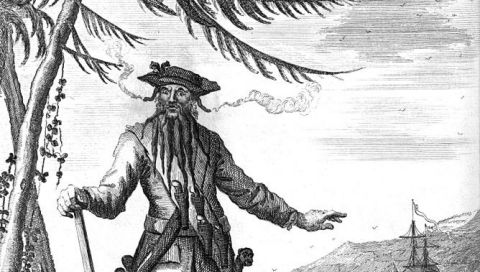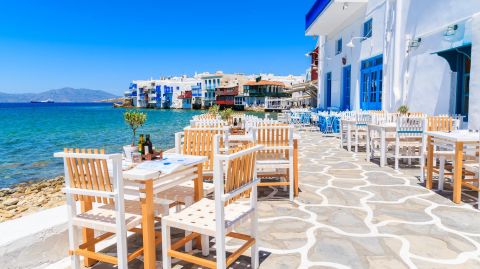The pirates of the Caribbean Sea
2025-03-17 16:09:02
In
the annals of maritime history, few tales captivate the imagination
quite like the saga of pirates in the Caribbean. From the 16th to the
18th century, these seafaring renegades roamed the azure waters,
striking fear into the hearts of sailors and merchants alike. With their
Jolly Roger flags flying high and cutlasses gleaming, they embodied
both terror and romance, leaving an indelible mark on the collective
consciousness. Let us embark on a voyage through time, delving into the
captivating world of Caribbean piracy.

A Treacherous Playground
The
Caribbean Sea, with its labyrinthine network of islands, proved to be
an ideal breeding ground for piracy. The regions strategic location at
the crossroads of lucrative trade routes between Europe, Africa, and the
Americas made it a treasure trove ripe for plunder. Moreover, the
presence of colonial powers vying for dominance provided ample
opportunities for piracy to flourish.
During
the 16th century, as Spain amassed vast wealth from its colonies in the
New World, its galleons laden with gold, silver, and other precious
commodities became prime targets for pirates. The Spanish Main,
stretching from the coasts of South America to the Florida Keys, emerged
as a battleground where daring buccaneers clashed with Spanish armadas
in a bid for riches and glory.
The Rise of the Buccaneers
The
term buccaneer originally referred to hunters who smoked and preserved
meat known as boucan on the islands of Hispaniola and Tortuga. These
rugged frontiersmen, often of French and English descent, possessed a
penchant for adventure and a fierce independent spirit. As Spanish
control over the Caribbean grew, many buccaneers turned to piracy,
launching daring raids on Spanish settlements and treasure fleets.
Among
the most infamous buccaneers was Sir Henry Morgan, whose audacious
exploits earned him both fame and notoriety. Leading raids against
Spanish strongholds such as Panama City and Porto Bello, Morgan amassed
immense wealth and became a symbol of defiance against Spanish rule. His
legendary raid on Panama City in 1671, though marked by brutality and
bloodshed, secured his place in the annals of piracy.
Pirate Havens and Hideouts
The
Caribbean offered sanctuary to pirates, providing remote coves and
hidden harbors where they could repair their ships, divide their spoils,
and carouse in raucous revelry. One such notorious haven was Port
Royal, situated on the island of Jamaica. Dubbed the Wickedest City in
the World, Port Royal was a haven for pirates, prostitutes, and rogues
of every stripe. Its streets echoed with the sounds of drunken merriment
and the clinking of ill-gotten gold.
Tortuga,
located off the coast of Hispaniola, was another infamous pirate
stronghold. Originally settled by French and English buccaneers, Tortuga
became a lawless haven where pirates operated with impunity, launching
raids on passing ships and terrorizing the Spanish colonies. From
Tortuga, pirates such as Captain Henry Every and Calico Jack Rackham set
sail on daring voyages that struck fear into the hearts of their
enemies.
The Code of the Brethren
Contrary
to popular belief, pirates adhered to a strict code of conduct known as
the Brotherhood of the Coast or the Pirates Code. This unwritten set of
rules governed every aspect of pirate life, from the division of spoils
to the treatment of prisoners. Among its provisions were democratic
decision-making, equal distribution of wealth, and harsh punishments for
betrayal or cowardice.
Pirates
elected their captains democratically, often choosing those who
demonstrated leadership qualities and tactical acumen. Captains were
granted authority in times of battle but were subject to removal if they
failed to uphold the interests of the crew. The egalitarian nature of
pirate society, though often romanticized, stood in stark contrast to
the hierarchies prevalent in the navies of the day.
Legends of the High Seas
The
golden age of piracy in the Caribbean produced a pantheon of legendary
figures whose exploits have echoed through the corridors of time. From
the fearsome Blackbeard, who struck terror into the hearts of his
victims with his bristling beard and smoking fuses, to Anne Bonny and
Mary Read, who defied gender norms to become fearsome pirates in their
own right, these larger-than-life characters have become the stuff of
myth and legend.
Yet,
for all their bravado and daring, the lives of pirates were fraught
with danger and uncertainty. Violent clashes with naval vessels,
mutinies within their own ranks, and the constant threat of capture and
execution loomed large on the horizon. For every pirate who met a
glorious end, countless others met a far less glamorous fate at the end
of a hangmans noose or the blade of an executioners axe.
The End of an Era
By
the early 18th century, the golden age of Caribbean piracy was drawing
to a close. The colonial powers, alarmed by the growing menace of
piracy, launched concerted efforts to eradicate the scourge from the
seas. Naval patrols increased, pirate strongholds were besieged, and
rewards were offered for the capture of notorious pirates. The era of
swashbuckling adventure gave way to a more regulated and orderly
maritime world.
In
1718, the death knell of Caribbean piracy sounded with the demise of
Blackbeard, who fell in battle against British forces off the coast of
North Carolina. With his death, the era of the great pirates came to an
end, consigned to the annals of history as a romanticized yet tumultuous
chapter in the saga of maritime adventure.
Legacy of the Pirates
Though
piracy in the Caribbean may have faded into the mists of time, its
legacy endures in the popular imagination. From the pages of literature
to the silver screen, pirates continue to capture our imagination with
their tales of daring escapades and swashbuckling heroism. The allure of
buried treasure, secret maps, and hidden coves continues to enchant
adventurers and dreamers alike, keeping alive the spirit of the pirates
of the Caribbean.










